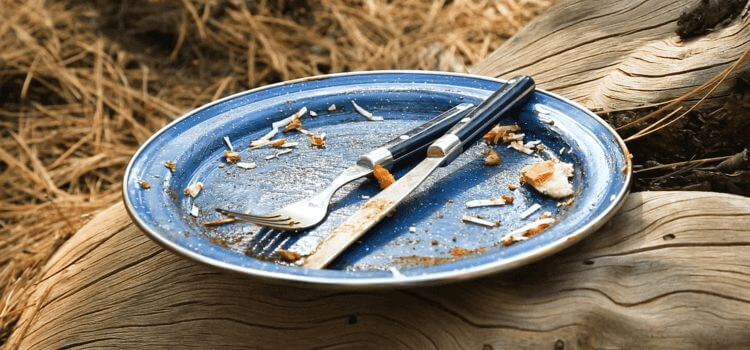As an Amazon Associate, I earn from qualifying purchases
To wash dishes while camping, use a scrub pad or similar tool and hot water to clean the dishes. Collect the wash water, called gray water, into a single pot and strain it to capture food residue.
Setting Up A Washing Station

Setting up a washing station while camping is essential for washing dishes. Use hot, soapy water in one bin, clean hot rinse water in another, and cold water with sanitizer in the third bin to ensure bacteria is killed. Strain the gray water and dispose of food residue properly.
Choosing The Right Equipment
Before you can set up a proper washing station for your camping dishes, you need to make sure you have the right equipment. Here are a few items you’ll need:
- A portable kitchen sink or basin
- Wash and rinse buckets
- Scrub pad or sponge
- Biodegradable camping dish soap
- Mesh or straining material
- Towels for drying
Setting Up The Kitchen Sink
Once you have the necessary equipment, it’s time to set up your camping kitchen sink :
- Choose a flat and stable surface for your sink, such as a sturdy table or a designated camping kitchen area.
- Place your portable kitchen sink or basin on the surface.
- Make sure the sink is secure and won’t tip over.
- Position the sink close to a water source, such as a river or a water container.
- Ensure there is a drainage system in place for the sink.
Preparing The Wash And Rinse Buckets
Now that your kitchen sink is set up, it’s time to prepare the wash and rinse buckets. Here’s what you need to do:
- Fill one bucket with hot water and camping dish soap. This will be your wash bucket.
- Fill another bucket with clean water. This will be your rinse bucket.
- Place a mesh or straining material over the wash bucket to capture any food residue.
- Ensure that both buckets are stable and won’t tip over during the dishwashing process.
With your washing station set up and your wash and rinse buckets ready, you’re now prepared to wash dishes while camping. Remember to conserve water and properly dispose of gray water to minimize your impact on the environment.
Washing The Dishes
When camping, washing dishes can be done by using three wash bins – one with hot, soapy water, one with clean, hot rinse water, and one with cold water and sanitizer. Strain the wash water to remove food residue, and always use biodegradable camping dish soap to protect the environment.
Starting With The Cleanest Dishes

When it comes to washing dishes while camping, it’s essential to start with the cleanest dishes first. This means separating the dirty dishes from the clean ones and tackling the cleaner dishes first. By doing this, you can ensure that the water and soap used for washing the dirtier dishes remain as clean as possible for optimal cleaning efficiency. To start, gather all the dirty dishes in a designated area and set aside the cleanest dishes that only require a quick rinse. This way, you can prevent cross-contamination and make the dishwashing process more manageable.
Using Biodegradable Camping Dish Soap

To minimize the environmental impact while camping, it’s crucial to choose biodegradable camping dish soap. Avoid using regular dish soap like Dawn, as these products often contain sulfites that can harm the environment. Biodegradable camping dish soap is specifically designed to break down naturally in the environment, ensuring your dishwashing routine is environmentally friendly and safe. Look for camping-specific dish soap options in outdoor stores or online, and read the labels to confirm their eco-friendly qualities before purchasing.
Washing With Hot Soapy Water

Once you have your biodegradable camping dish soap, it’s time to start washing the dishes. Fill a basin or a large container with hot water and add the soap according to the instructions on the bottle. Make sure the water is hot enough to remove grease and food residue effectively. Use a scrub brush or sponge to scrub each dish thoroughly, paying close attention to areas with stubborn stains or stuck-on food. Rinse the scrubbed dishes with clean water after washing to remove any remaining soap residue.
Rinsing With Clean Hot Water

After washing the dishes with hot soapy water, it’s crucial to rinse them thoroughly with clean hot water. This step ensures that all the soap residue is removed, leaving your dishes clean and ready for use. Fill another basin or container with hot water and use it to rinse off the soap from each dish. If you’re limited on water supply while camping, try to conserve water by rinsing multiple dishes together in a single batch. Repeat the rinsing process until all the dishes are free from soap residue.
Straining Out Food Scraps

As you rinse the dishes, it’s essential to strain out any food scraps or particles to prevent them from entering the water system. Use a mesh strainer, a bandana, or a plastic bag with straining holes to capture the food residue and prevent it from polluting the environment. Straining out food scraps also helps in reducing waste and makes proper disposal easier. Once all the dishes have been rinsed, discard the captured food scraps in a trash bag or designated trash area. Remember to leave your camping space as clean as you found it.
Disposing Of Gray Water And Cleaning Up
When it comes to washing dishes while camping, it’s important to not only clean your dishes but also properly dispose of the gray water and clean up your campsite. In this section, we will discuss three key aspects of this process: consolidating gray water, disposing of food scraps in the trash, and broadcasting gray water.
Consolidating Gray Water

Before disposing of gray water, it’s essential to consolidate it into a single container to minimize the impact on the environment. Start by collecting the wash water, also known as gray water, into a large pot or bucket. Make sure to strain the water to capture any food residue using a mesh or a plastic bag with straining holes cut into it. This will prevent any solid particles from being released into the environment.
Disposing Of Food Scraps In The Trash
Once you have consolidated the gray water, it’s time to dispose of any food scraps. Instead of scattering them around your campsite, it’s best to put them in a sealed bag and throw them in the trash. This not only helps keep the campsite clean but also prevents attracting animals to your area.
Broadcasting Gray Water
After consolidating gray water and disposing of food scraps, the next step is to broadcast the gray water. Broadcasting gray water means distributing it over a large area away from your campsite. This allows the water to be absorbed by the ground and minimizes its impact on the ecosystem. Make sure to follow any specific guidelines or regulations provided by the campsite or park authorities regarding gray water disposal.
Now that you have taken care of disposing of gray water and cleaning up, it’s time to clean the wash and rinse buckets to ensure proper hygiene. Scrub the buckets thoroughly with hot water and biodegradable camping dish soap, making sure to remove any food residues or debris. Rinse the buckets with clean water and let them air dry before storing them.
Frequently Asked Questions Of How To Wash Dishes While Camping
How Do People Wash Dishes When Camping?
To wash dishes when camping, use a scrub pad and hot water to clean. Collect the wash water, or gray water, in one pot and strain it to remove food residue. Use biodegradable dish soap and three wash bins: one with soapy water, one with rinse water, and one with sanitizer.
How Do You Wash While Camping?
To wash dishes while camping, use a scrub pad and hot water. Collect the wash water in a pot and strain it to remove food residue. Use biodegradable dish soap and three wash bins: one with hot soapy water, one with hot rinse water, and one with cold water and sanitizer.
Is Dawn Soap Safe For Camping?
Yes, Dawn soap is safe for camping. Use biodegradable camping dish soap, not Dawn or other sulfite-containing products. Use hot water with a scrub pad to clean dishes and collect the wash water (gray water) in a single pot. Strain the gray water to remove food residue.
What Is The 3 Bucket Wash Method Camping?
The 3 bucket wash method for camping involves using three wash bins. The first bin has hot, soapy water, the second has clean, hot rinse water, and the third has cold water with a sanitizer like bleach to kill bacteria.
Wash the dishes with the soapy water, rinse in the second bin, and sanitize in the third bin.
Conclusion
To wash dishes while camping, follow these steps for a clean and efficient experience. Start by using a scrub pad or similar tool to clean the dishes with hot water. Collect the wash water, or gray water, in a pot and strain it to remove food residue.
Remember to use biodegradable camping dish soap to minimize environmental impact. Finally, rinse the dishes with clean hot water and sanitize them if desired. With these tips, you can keep your campsite clean and hygienic while enjoying your outdoor adventures.
Read More
How to Insulate a Tent for Winter Camping
How Many Camps Are on Mount Everest
As an Amazon Associate, I earn from qualifying purchases

